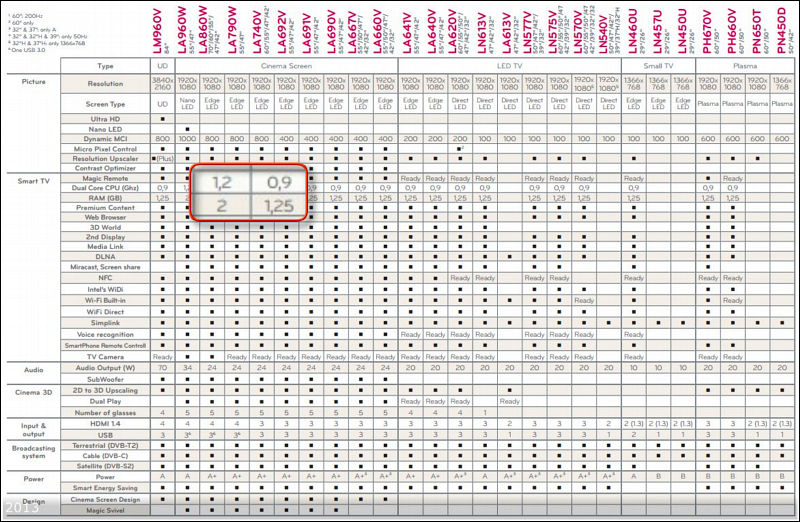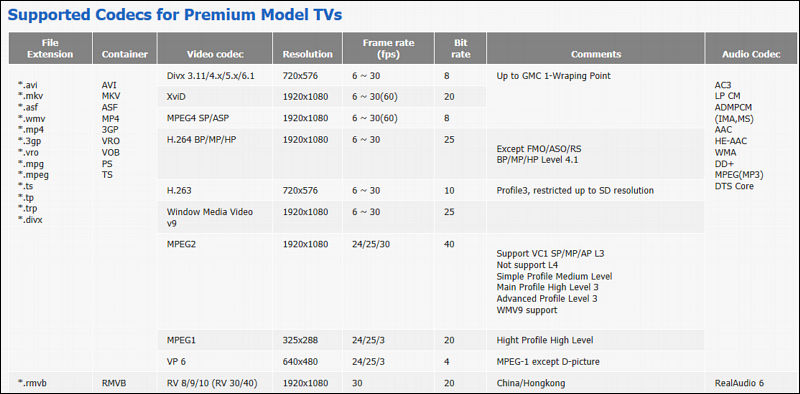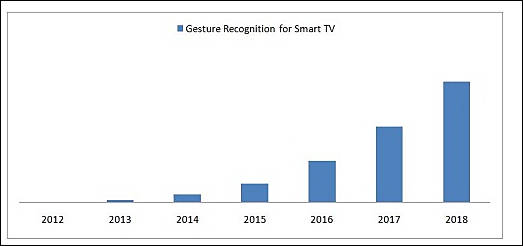
-

LG. Table above show features and main CPU specs for Europe 2013 line.
As you can see - it is below cheapest (I mean $50-60 here) tablets specs (2012 TVs had super slow single core CPU).
Works on Linux and proprietary StupidTV interface.Btw, below is video codecs supported by 2013 Samsung TVs (only top lines)

-
Vizio and stupid custom tablet as remote
Small tip. Tablets just die if used as remotes. And fast.
-
Tizen can also be installed on home appliances such as refrigerators, washing machines, air conditioners and robot vacuums. In the age of the Internet of Things where countless devices will be connected to each other, Tizen will make the TV in your living room a control center for your devices.
Ouch my god. Again heavy drugs used by top management.
http://global.samsungtomorrow.com/when-samsung-smart-tv-meets-tizen-editorial/
-
StupidTV from Panasonic PR
Panasonic has collaborated with Mozilla to introduce a new, intuitive user interface for its 2015 TV line-up, powered by Firefox OS. Panasonic’s 2015 4K UHD (Ultra HD) LED VIERA TV line-up is equipped with a range of new functions and features, including my Home Screen 2.0 and Info Frame, designed to ensure you can enjoy your favourite channels, apps and devices faster and more efficiently than ever.
New, intuitive, customisable user interface
To provide a graphically rich, intuitive interface that makes it quick and easy for you to track down your favourite content with ease, Panasonic has introduced Firefox OS in the 2015 4K UHD VIERA TV line-up.
The platform, incorporating the new my Home Screen 2.0, is specifically designed to allow you to access preferred content quickly and easily. The home screen can be completely personalised to suit your preferences and is divided into easy to navigate ‘decks’. Three decks come as default with the platform:
-
Samsung TVs now insert advertisements in AU
-
Sony (at least it is Android based)
-
Third non necessary OS in StupidTVs. Panasonic bring Firefox OS to TVs.
So, we have - Web OS (LG), Tizen (Samsung), FireFox OS (Panasonic), all of this will be dead soon.
And also Android that has some potential and used by Sony and Sharp.
-
Samsung Electronics announced that all of its Smart TVs in 2015 will come equipped with its new platform built around the Tizen operating system. Tizen, a standardized open-source platform, enables flexibility with even more content and devices, allowing developers to easily create compatible content, while connecting users to a world of limitless entertainment possibilities.
Bold move.
-
At the 2015 International CES® from Jan. 6-9 in Las Vegas, LG Electronics (LG) will be unveiling an impressive TV lineup featuring the company’s newest webOS 2.0 Smart TV platform. LG’s webOS 2.0 is specifically designed to enhance the key features found in the current generation of Smart TVs, resulting in an outstanding user experience unmatched by any competing system. What’s more, LG is working with content providers such as Amazon and Netflix to ensure that LG TV owners are guaranteed a wide range of viewing options in brilliant 4K resolution.
LG’s webOS 2.0 takes simplicity and convenience to a whole new level even while managing more content options than ever before. webOS 2.0 offers a long list of improvements and impressive features. Boot time has been reduced by up to 60 percent and accessing content has been made significantly smoother and faster. When switching from the Smart TV Home Screen to YouTube, for example, users will see an improvement in loading time of up to 70 percent.
Short version - "We made shit less shitty, please buy our new TV"
-
Japan- and South Korea-based international LCD TV vendors as well as China-based vendors are expected to promote Ultra HD smart LCD TVs featuring connectivity with smartphones and handheld devices in 2015, according to industry sources in Taiwan.
The TVs are expected to be connected through Android as a means for consumers to increase connectivity through their handheld devices and will be a target for vendors to increase their competitive edge in the market as the Ultra HD TV market continues to grow.
Again?
-
Sony has announced that their whole 2015 HD and 4K smart TV line-up will come with Android TV.
http://www.mobilegeeks.com/sony-android-tv/
Not bad. Only thing lefts is to kill WebOS and Samsung OS.
-
"In developed regions 30% of homes will own a smart TV by the end of 2014, rising to 70% by 2018," said Jack Wetherill, senior market analyst at Futuresource Consulting.
My god.
"There is little opportunity for TV vendors to monetize apps or content, with consumer interest concentrated on free or subscription video, and far lower interest in other genres or general web use - a radically different profile to the mobile market,"
Surprize.
This smart TV juggernaut may mean more TV vendors gravitate towards Android TV, as Google would share the load of future development and support
And this is good news.
-
Strategy Analytics estimates the price premium relative to a dumb TV to be between $30 and $75, depending on the model — without any of the inherent advantages of external devices.
It is complicated, all "dumb" TVs actually run on Linux, almost all of current modern TV LSI can be made into SmartTVs, you can only add small amount of RAM compared to "dumb" ones and add Wi-Fi antennas and, sometimes, adapter chip.
TV makers have chosen to build the smartphone right into the TV. The most literal example of this (and current state of the smart TV art) is LG’s webOS-powered Smart+ TV.
Nope, most literal example is Chinese brands who just install normal Android.
The only way to overcome the asynchronicity of some internal components becoming outdated faster than the overall TV is to take those components out. That’s exactly what Samsung does with its $249 Smart Evolution Kit, which adds a quad-core processor and the 2014 version of the company’s Smart Hub software to select 2012 HDTV models.
Looking to first comment you can understand why this is ILLOGICAL way for TVs. As their mail LSI are very very similar to chips used in smartphones (modern ones have good GPU and 4 ARM cores).
The smart TV is an abortive attempt at technological convergence that generates more compromise than convenience. There’s
It is not, really. It is just attempt to make all software by themselves and get big money. If, instead, korean brands financed proper chips development and used common OS (Windows or Android) it'll be all different thing.
http://www.theverge.com/2014/11/13/7213611/bring-back-the-dumb-tv
-

The gesture recognition market is expected to reach $479.88 Million in 2018 from the year 2012 at a CAGR of 131.26% from 2012 to 2018.
Sounds dangerous.

 sigma_6.jpg523 x 246 - 13K
sigma_6.jpg523 x 246 - 13K -
LG Electronics' 55-inch curved OLED TV (55EC9300) will be sold for 3.99 million won (US$3,775) per unit through major retail channels and department stores in Korea, according to a statement from LG that was reported in Korea-based ET News.
The new price tag is more than a 70% drop since its original price of 15 million won back in April 2013. The move is in order to push LG OLED TVs further into the market, as the company believes OLED is the "future of TVs," the report said.
Good news.
-
Things were looking up in early 2013 for the team behind webOS, a pioneering but star-crossed mobile operating system. After surviving the implosion of Palm and a rocky acquisition by HP, LG stepped in to buy the team. The consumer electronics giant seemed like a white knight with a plan: To make webOS the core of LG’s next-generation smart TV platform, and use the brains behind webOS to create a much-needed engine of innovation at LG. To create a unit that was meant to help the company to beat competitors like Samsung with Silicon Valley smarts. A disruptive force.
Eighteen months later, the acquisition looks a lot like a failure. About a third of the webOS team has left LG since the acquisition, including some recent high-profile departures. Others are close to making the jump, as early euphoria has been displaced by disillusionment and frustration. The LG Silicon Valley Lab, as the webOS unit is now officially called, introduced LG’s first webOS-based smart TV at CES in January, but the road to Vegas was rocky, and the device unveiled at the show almost didn’t happen, save for a few lucky accidents.
I’ve talked to a number of current and former webOS team members as well as people with knowledge about the decision making process within LG over the last couple of weeks, and the picture emerging from those interviews is an ugly one, full of fights and corporate politics. It’s a story about about a failed acquisition, but also about the changing realities of consumer electronics, which are transforming from simple appliances to smart devices at a speed that often leaves big, slow-moving companies at a loss.
WebOS team also struggled with a culture clash of sorts that pitted company politics against its attempt to simplify the company’s smart TV platform. Sources told me that LG had a policy in place to reward managers with bonuses or even promotions if their features were part of the final product. The result was a constant feature bloat, as everyone tried to add on one more thing.
http://gigaom.com/2014/08/28/a-failed-experiment-how-lg-screwed-up-its-webos-acquisition/
-
the displays are not glare-free anymore,
Search shops better :-)
have bad static contrast due to "edge-lighting"
Edge lighting really has little to do with contrast. Good edge lighting with proper light guides make very good TV. With full backlight you can get better local contrast by switching them off completely, but in mass products it is no way to go.
and lack color brilliance due to white-LED-only lighting.
LED backlight TVs can have quite accurate colors, be it standard gamut or wide one. All depend on manufacturer. As primary colors are defined by filters (and also by leds used, of course). If you open spectrum of any more or less decent led you'll see that it is not of any issue to cut proper spectrum portions.
-
It's depressing how they hype all those irrelevant gimmick features, while at the same time, the displays are not glare-free anymore, have bad static contrast due to "edge-lighting" and lack color brilliance due to white-LED-only lighting.
I'm waiting for a non-glare 4k OLED without(!) stupid "curving", I want a flat surface that looks good from more than one spot.
-
New Android TV
-
Does it really upset you so much, VK?
It upsets me, yep. All this shit. It seems like big companies just want to find that to do for all their big developers hordes.
Just install pure latest Android, you can modify launcher if you want, but all this "youtube", "hulu" etc for hamsters upset me.
Where the fuck is all government agencies, how it all correlate with "preinstalled IE in Windows is evil"? Or all of them are just too afraid that they can't even piss thinking that corporations can do to them?
-
LOL, this thread is really fun to read :D
Especially VK's comments :p
Does it really upset you so much, VK?
It is possibly just a desperate search for any kind of innovation-like features. Maybe less stupidity than orders of the bosses. What do you think? -
According to documents obtained exclusively by The Verge, Google is about to launch a renewed assault on your television set called Android TV. Major video app providers are building for the platform right now. Android TV may sound like a semantic difference — after all, Google TV was based on Android — but it’s something very different. Android TV is no longer a crazy attempt to turn your TV into a bigger, more powerful smartphone. "Android TV is an entertainment interface, not a computing platform," writes Google. "It’s all about finding and enjoying content with the least amount of friction." It will be "cinematic, fun, fluid, and fast."
http://www.theverge.com/2014/4/5/5584604/this-is-android-tv
NOOOOOOOOOOOOOO!!!
Main thing here is that it cost from $0 to $50 to add good and normal Android. I have no idea why you need "Android for ones with dementia" thing.
-
The company's new 55-inch 8809 series set mates the extra-high resolution with Android, giving you both Google Play apps as well as access to your Dropbox content. It's also a capable set whether or not you like the mobile OS, with a 1GHz refresh rate and Ambilight illumination that plays nicely with both games and Hue lights. There are also 48- and 55-inch 1080p sets running Android .
As expected Chinese market trends go worldwide. Android works ok if implemented properly on TVs.
-
In the end, it’s about patience and compromise. The chances of seeing the TV industry ruled by a single operating system (like Android on phones) is growing lower with each passing year. Google tried and failed with Google TV, and with the company still licking its wounds, we don’t expect to see another attempt any time soon.
Quite fun article from guys who do not know that they are writing about and lack any knowledge on Chinese market. Btw all this young dumb asses journalists are one of the main reasons why we have such StupidTV state.
http://www.theverge.com/2014/1/10/5284828/iq-test-the-state-of-smart-tvs-ces-2014
-
At least it is now fully clear that Panasonic TV division is going the way of dodo.
-
Here goes Panasonic
Panasonic and Mozilla to Collaborate on New Firefox OS Open Platform for Next Generation Smart TVs
Osaka, Japan / Mountain View, USA - Panasonic Corporation and Mozilla today announced that the two companies have agreed to form a partnership to develop and promote the new Firefox OS, an open platform based on HTML5 and other Web technologies, for next generation smart TVs.
The development of the new Firefox OS platform aims to deliver more expansive access into smart TVs by leveraging the HTML5 and Web technologies already prevalent on PCs, smartphones and tablets, to offer consumers more personalized and optimized access to Web and broadcasting content and services through the Internet.
With the launch of this new open platform, next generation smart TVs will gain full compatibility with Web technologies and HTML5 standards used for cloud services and various future networked devices, enabling data from Web services and devices to be easily mashed up on a single application. This ensures flexibility for developers to create new applications and services by using cross-leveraged content from the Internet and broadcasting. By using new Mozilla-pioneered WebAPIs for hardware control and operation, next generation smart TVs will also be capable of monitoring and operating devices inside and outside of the home, such as the emerging smart home appliances.
In next generation smart TVs, basic functions, such as menus and EPGs (Electronic Program Guide) which are currently written as embedded programs, will be written in HTML5, making it possible for developers to easily create applications for smartphones or tablets to remotely access and operate the TV. In addition, through the Web services, next generation smart TVs can display personalized user interfaces, featuring the user’s favorites and even add new functions for multiple users sharing the same screen after devices are purchased.
“Panasonic had been expanding content and services dedicated for Panasonic TVs on our own portal site and our collaboration with Mozilla on Firefox OS will further accelerate various innovations and encourage many new services,” said Mr. Yuki Kusumi, Director of the TV Business Division of the AVC Networks Company of Panasonic. “Through Panasonic’s partnership with Mozilla, we will create further innovation in smart TV technologies and features, which will take consumers to a whole new level of interaction and connectivity inside and outside of the home.”
“We are very excited to partner with Panasonic to bring Firefox OS to more people on more platforms. As we see more partners supporting Firefox OS and the open Web, Firefox OS helps solidify open Web standards for smart screen solutions,” said Dr. Li Gong, Senior Vice President of Mobile Devices and President of Asia Operations at Mozilla. “This new platform enables developers and service providers to create a wide range of applications and services to deliver a new user experience. We see a strong alignment between the visions of Mozilla and Panasonic, and by combing our collective expertise and know-how, we will create amazing products together.”
Panasonic will release next generation smart TVs powered by Firefox OS, and Mozilla and Panasonic will work together to promote this Firefox OS and its open ecosystem.
Howdy, Stranger!
It looks like you're new here. If you want to get involved, click one of these buttons!
Categories
- Topics List23,925
- Blog5,719
- General and News1,337
- Hacks and Patches1,148
- ↳ Top Settings33
- ↳ Beginners254
- ↳ Archives402
- ↳ Hacks News and Development56
- Cameras2,345
- ↳ Panasonic985
- ↳ Canon118
- ↳ Sony154
- ↳ Nikon95
- ↳ Pentax and Samsung70
- ↳ Olympus and Fujifilm98
- ↳ Compacts and Camcorders296
- ↳ Smartphones for video96
- ↳ Pro Video Cameras191
- ↳ BlackMagic and other raw cameras117
- Skill1,959
- ↳ Business and distribution66
- ↳ Preparation, scripts and legal38
- ↳ Art149
- ↳ Import, Convert, Exporting291
- ↳ Editors190
- ↳ Effects and stunts115
- ↳ Color grading197
- ↳ Sound and Music280
- ↳ Lighting96
- ↳ Software and storage tips266
- Gear5,408
- ↳ Filters, Adapters, Matte boxes344
- ↳ Lenses1,578
- ↳ Follow focus and gears93
- ↳ Sound496
- ↳ Lighting gear313
- ↳ Camera movement230
- ↳ Gimbals and copters302
- ↳ Rigs and related stuff271
- ↳ Power solutions83
- ↳ Monitors and viewfinders339
- ↳ Tripods and fluid heads139
- ↳ Storage286
- ↳ Computers and studio gear559
- ↳ VR and 3D248
- Showcase1,859
- Marketplace2,834
- Offtopic1,316






